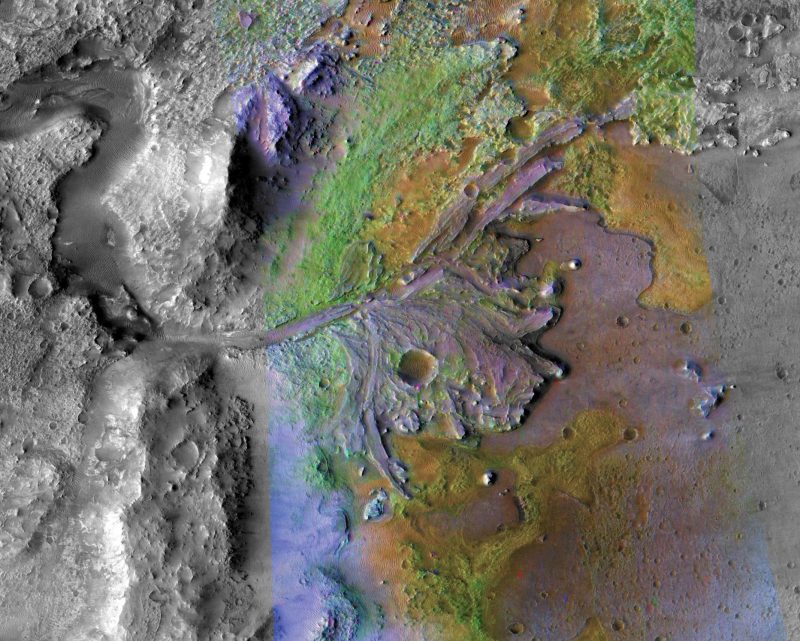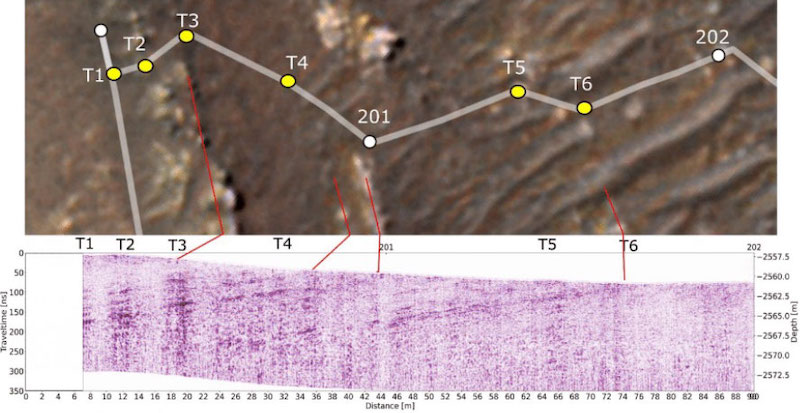
NASA’s newest Mars rover is the Perseverance rover. It’s been exploring Jezero Crater on Mars since its landing there on February 18, 2021. Late last month (December 15, 2021), mission scientists announced some surprising new discoveries, from the first 10 months of Perseverance’s sojourn in this ancient lakebed. The new insights from Perseverance are helping to answer some key questions about the region. Could it have supported life in the past? The rover has found new evidence for ancient hot magma and abundant water. It has also discovered ancient organic molecules, the sorts of molecules found in all living things, still preserved in rocks and dust.
All of these findings provide important clues about the conditions in this region a few billion years ago. Jezero Crater once held a lake, and an ancient river delta is still clearly visible today.
10 months of Perseverance: new science results from Mars
The results were presented on December 15, 2021, at a news briefing during the American Geophysical Union (AGU) fall meeting in New Orleans. You can watch the entire briefing here on YouTube. As outlined in the description:
NASA’s Perseverance Mars rover has spent the 10 months since its landing exploring two very different geologic units on the Jezero Crater floor. After exploring and taking its first two samples from the Crater Floor geologic unit [Crater Floor Fractured Rough], Perseverance entered Séítah geologic unit in October. The rover has spent the last several months analyzing multiple outcrops of Séítah, allowing the science team to begin to understand the relationship between these unique geologic units and their place in the geologic history of Jezero. What scientific discoveries have Perseverance’s on-board investigations made to date, and what explorations are still to come; in Séítah, and down the road at the crater’s intriguing ancient river delta?
These new investigations by the Perseverance rover come from no less than 22 science papers, all peer-reviewed.
Red-hot magma
Even though there has already been good evidence for the former lake, scientists still wondered about the composition of parts of Jezero’s crater floor. Were the rocks igneous, formed from once-flowing lava? Or were they sedimentary, composed of minerals carried by the ancient river into the lake? The new results show that at least part of the crater floor is formed from lava. Ken Farley, a Perseverance project scientist at Caltech, stated:
I was beginning to despair we would never find the answer. But then our PIXL instrument got a good look at the abraded patch of a rock from the area nicknamed ‘South Séítah,’ and it all became clear: The crystals within the rock provided the smoking gun.
How did the rover make this discovery? Basically, it used its robotic arm to grind into rocks. Then, other instruments examined the freshly ground surfaces in detail to determine the composition.

Alteration by water
Scientists used the Planetary Instrument for X-ray Lithochemistry, or PIXL, to analyze a rock called Brac in the South Séítah region. Intriguingly, the analysis revealed large olivine crystals engulfed in pyroxene crystals. What does that mean? Essentially, this is evidence for both magma and water in the distant past, as Farley explained:
A good geology student will tell you that such a texture indicates the rock formed when crystals grew and settled in a slowly cooling magma; for example a thick lava flow, lava lake or magma chamber. The rock was then altered by water several times, making it a treasure trove that will allow future scientists to date events in Jezero, better understand the period in which water was more common on its surface and reveal the early history of the planet. Mars Sample Return is going to have great stuff to choose from!

Scientists don’t know for sure yet if the olivine-rich rock formed in a cooling lava lake on the surface or below ground.
Organics in rocks and dust
Another exciting discovery is that of organic compounds in both rocks and dust. Perseverance used its Scanning Habitable Environments with Raman & Luminescence for Organics & Chemicals (SHERLOC) instrument to detect them. Organics are a tantalizing finding, since they are the building blocks of life. However, both biological and non-biological processes can create organics. Whether these particular organics are from once-living organisms or not is something scientists must still determine. This also isn’t the first time we’ve found organics on Mars. According to Luther Beegle, SHERLOC principal investigator at NASA’s Jet Propulsion Laboratory:
Curiosity also discovered organics at its landing site within Gale Crater. What SHERLOC adds to the story is its capability to map the spatial distribution of organics inside rocks and relate those organics to minerals found there. This helps us understand the environment in which the organics formed. More analysis needs to be done to determine the method of production for the identified organics.
Even if these organics themselves aren’t left over from actual microbes, their discovery shows that such biosignatures – chemical or fossil traces of once-living organisms – can be well preserved. Beegle said:
This is a question that may not be solved until the samples are returned to Earth, but the preservation of organics is very exciting. When these samples are returned to Earth, they will be a source of scientific inquiry and discovery for many years.

Ground-penetrating radar
Perseverance is also the first Mars rover to use ground-penetrating radar. The RIMFAX (Radar Imager for Mars’ Subsurface Experiment) creates a “radargram” of subsurface features up to about 33 feet (10 meters) deep. Perserverance obtained the first radargram at a ridgeline between the Crater Floor Fractured Rough geologic unit and the Séítah geologic unit.
The data show that multiple rock formations below the surface all have the same angle of tilt. The Séítah rock layers also project below those of the Crater Floor Fractured Rough. This implies that Séítah was formed before Crater Floor Fractured Rough.
Bottom line: NASA announced exciting new results from the first 10 months of Perseverance exploring an ancient lakebed on Mars, from magma to organics. Scientists announced the findings at the 2021 fall meeting of the American Geophysical Union in New Orleans.











